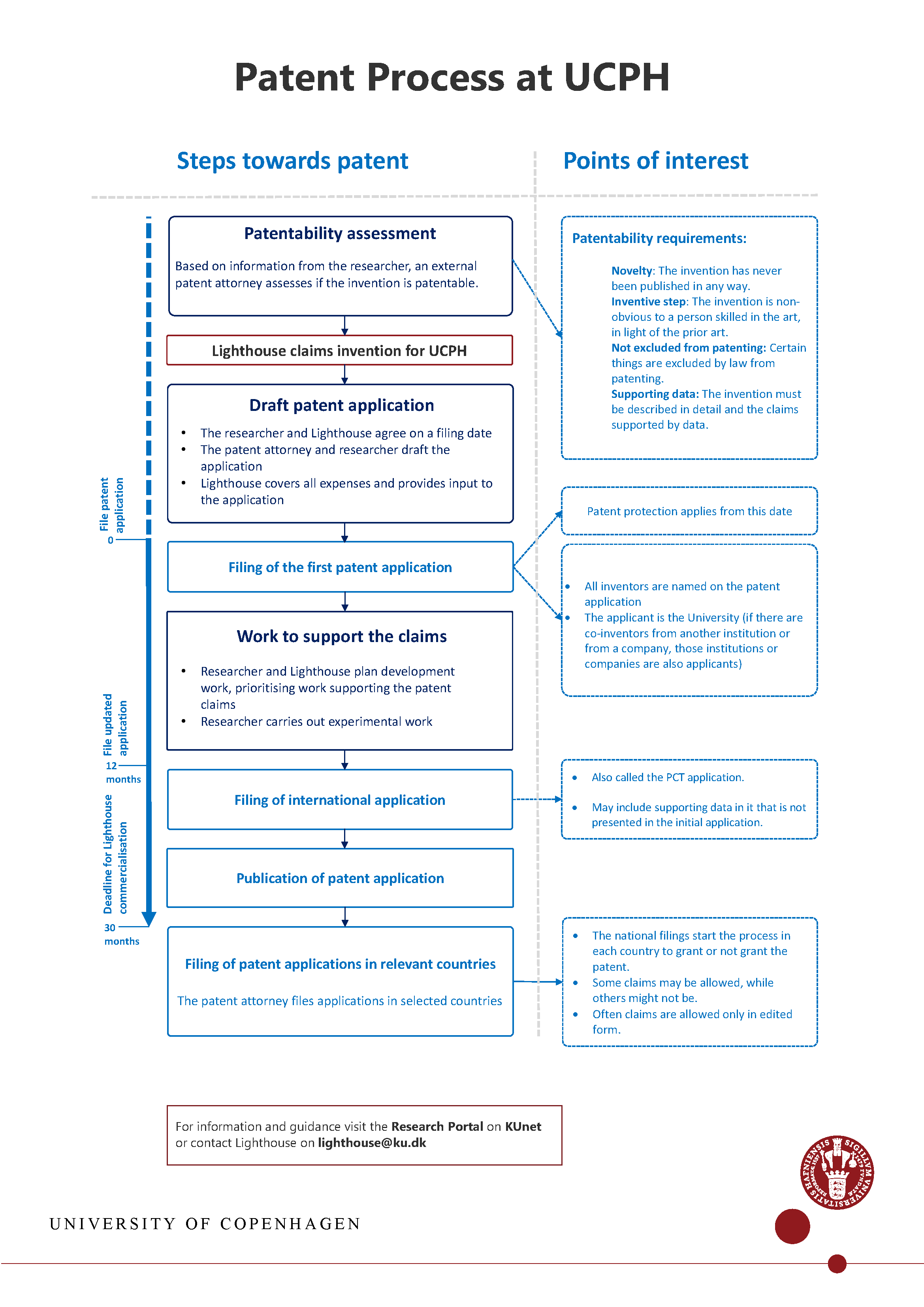Commercialisation of inventions
Lighthouse can help you through the entire commercialisation process if you have made an invention. See what the commercialisation process looks like here.
1. Report your invention to KU Lighthouse
Employees at the University of Copenhagen who make an invention must (by law) disclose the invention to KU Lighthouse.
If you think you have made an invention, you must fill out an Invention Disclosure Form (IDF) and email the signed IDF to KU Lighthouse (IDF@adm.ku.dk).
Remember to get signatures from all KU-employed inventors and your department head(s). In addition, be sure to list any students if they are also potential co-inventors.
2. Registering your potential invention
Lighthouse will register your submission and contact you to arrange a meeting. If any of your co-inventors are employed outside the University, KU Lighthouse will contact the relevant organisations.
3. Assessment of the invention
Once you have reported your invention, Lighthouse has two months to assess whether UCPH will take over the rights to the invention and start the patenting and commercialisation process.
The assessment typically consists of an external patentability assessment and an assessment of the invention's commercial potential - and always with the involvement of you as the inventor. The assessment includes factors such as expertise, time, market, funding, data and publication plans.
In addition, KU Lighthouse investigates whether there are any agreements that could influence a possible commercialisation. This could, for example, be a collaboration agreement, a material transfer agreement or conditions in connection with the research grant.
Based on the overall assessment, Lighthouse decides whether UCPH should take over the rights to the invention and thus attempt to commercialise it.
All expenses are borne by Lighthouse.
4. If UCPH takes over the rights to the invention
If UCPH takes over the rights, Lighthouse will work with you to organise a patenting and commercialisation plan, taking into account your wishes for publication and further work with the invention.
Read more about patenting and publishing under point 7.
It is important that you consider early on in the process whether you want to start your own company based on the invention.
Read more under Start your own business
If you do not want to start your own company, KU Lighthouse will seek out companies that might want to enter into a licence agreement.
Depending on the specific plan, UCPH Lighthouse will contact external parties who may be interested in licensing, collaborating on or investing in the invention.
- You must be prepared to participate in meetings with potentially interested commercial partners.
- You are the subject matter expert and collaboration with you is crucial to the success of the project.
In addition, you and KU Lighthouse should consider together which experiments or studies will benefit the project. For example, experiments that minimise the risk of the project not succeeding. But it can also be experiments that support and strengthen the patent application. In some cases, UCPH can support this with Proof of Concept funds.
Innovation Fund Denmark's Innoexplorer funds can also be used for such commercially-oriented projects, they can be a natural extension of a PoC grant from UCPH.
Experimental work can be carried out by you and your colleagues, or it can be outsourced. All expenses are borne by Lighthouse.
5. Licence agreement on the exploitation of inventions
When an interested licensee has been identified, UCPH Lighthouse negotiates a licence agreement with them. UCPH Lighthouse also takes care of the subsequent work of maintaining the agreement.
The licence agreement can be with an existing company or with your own spin-out company if you have chosen to start one.
If the return from the licence agreement is profitable, it will be divided in three: one third to UCPH, one third to the institute (or institutes) and one third to the inventors.
6. If the University does not take over the rights to the invention
If the University does not take over the rights to the invention, you retain ownership of your (share of) invention(s) and you are free to dispose of it. This also means that you must pay all costs for patenting and commercialisation yourself.
Your work on this must be outside the hours you work for the University and must be done without using the University's facilities. Note that the University is still entitled to a share of the profits if you succeed in commercialising your invention.
Lighthouse has compiled this advice for you if you want to commercialise your invention yourself.
7. Patenting and publishing
You don't have to worry that patenting will delay the publication of your research. Lighthouse will work with you to create a plan for patenting and publishing.
However, as you cannot patent something that has already been fully or partially published, it is important that you contact Lighthouse as early as possible so that we can make a plan together.
A ‘publication’ is for example:
- Articles
- Posters (e.g. from scientific conferences)
- Power Point presentations that are shared with people outside the research group at UCPH
- Seminar presentations
- Public meetings about the result where more than just the inventors are present.
- YouTube videos
- Thesis defence
- PhD defence
If you are in doubt about whether your activities can be interpreted as a publication or how to handle confidential information in connection with thesis and PhD defence, please contact Lighthouse.
8. The patenting process
Lighthouse will work with you to develop a plan for patenting your invention. You must be prepared to work closely with the external patent agent in drafting and maintaining the patent application.
You are the subject matter expert and your contribution is crucial to a successful patent application. Together with the patent agent, Lighthouse will keep you updated and informed about important deadlines so that you and Lighthouse can prepare responses to the authorities etc. in good time.
All expenses are covered by Lighthouse.

Read more about patenting on the website of the Danish Patent and Trademark Office.
